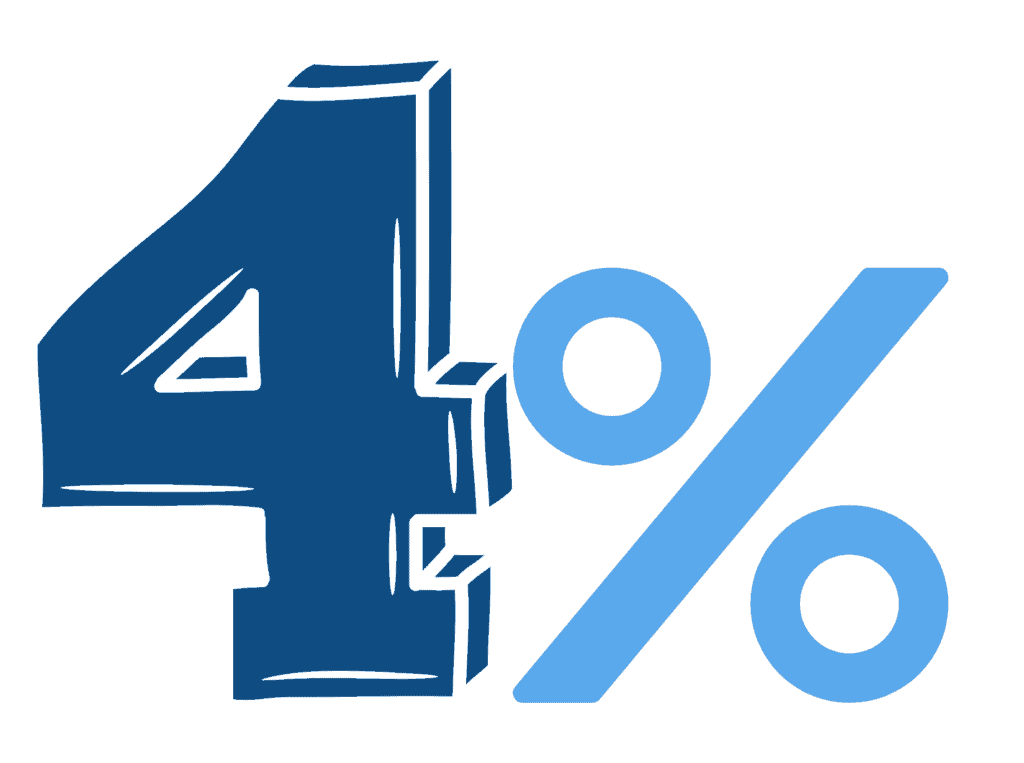Key Takeaways:
- The 4% rule is a widely accepted retirement withdrawal guideline that states you can take up to 4% of your portfolio per year in retirement without running out of money.
- It can help you fully define your retirement number and relieve financial stress.
- You can start a blog or rental property business to build passive income and help stretch your retirement nest egg.

Want to know what the 4% rule is?
Well, you’ve come to the right place.
We’ll tell you all about this FIRE rule.
It’s helped hundreds of thousands of people retire early, some even at 30!
So enjoy the helpful article below, discover the 4% rule, why it’s essential for early retirement, and more.
Let’s go!
What Is The 4% Rule?

It’s pure magic! The 4% rule is a retirement rule that says you can withdraw 4% of your portfolio annually in retirement and not run out of money.
For example, let’s say you have a $1 million portfolio. Your annual withdrawals could be $40,000 the first year of retirement, $41,600 the second year, $43,200 the third year, and so on, depending on your returns. This rule of thumb has been around for a long time and is still a good starting point for retirement planning.
There are a few things to remember with the 4% rule.
First, it’s a starting point. You may need to adjust your retirement withdrawals up or down based on your experience.
Second, the 4% rule could assume a portfolio of stocks and bonds. If your portfolio is mainly made up of stocks, you may be able to withdraw more than 4%. If it’s primarily bonds, you may need to withdraw less.
Third, the rule assumes you’ll adjust your withdrawals for inflation each year. So, if inflation runs at 3% per year, you’d increase your withdrawals by 3% yearly.
Fourth, the rule assumes you’ll live for at least 30 years or more in retirement. If you think you may not live that long, you may need to withdraw less than 4%.
The 4% rule is a good starting point for retirement planning. It’s not a hard and fast rule, but it can give you a good idea of how much income you can expect from your retirement portfolio.
When used with other free retirement planning tools like Personal Capital, the 4% rule can help you build a retirement plan that will last a lifetime.
Where Did The 4% Rule Come From?
The idea of the 4% Rule came from Bill Bengen, a financial advisor in Southern California who first coined it in the mid-1990s. The 4% rule was developed based on historical data on stock and bond returns spanning 50 years, beginning in 1926 and concluding in 1976. The severe market downturns of the 1930s and early 1970s were heavily emphasized.
The original research of the financial advisor William Bengen found that a portfolio consisting of 50% stocks and 50% bonds would have failed to support a 4% annual withdrawal rate only 3% of the time. More specifically, he said that retirees who want a higher success rate should aim for a 50-75% stock allocation.
Despite its simplicity, the 4% withdrawal rule is surprisingly robust in various market conditions. For example, a retirement portfolio following the 4% rule and a traditional 60/40 stock/bond allocation would have weathered the financial crisis of 2008 a lot better than those that didn’t follow this rule.
However, it’s important to remember that the 4% rule is a guideline, not a hard and fast rule. Retirement portfolios are unique, and the correct withdrawal rate will depend on various factors, including the individual’s risk tolerance and time horizon.
What Are The Benefits of The 4% Rule?

Plenty of benefits come along with following the 4% rule. Let’s dive into a couple:
For starters, the 4% rule can help you retire much earlier than the traditional retirement age of 65. This is because it helps define the value you need to retire. So many people just work until 65 because they “think” they don’t have enough money or their funds will expire, but they never take a seat back and assess how much they need.
Another benefit of the 4% rule is that it can help relieve stress. This is because it provides a clear guideline on how long your retirement savings will last.
For example, If you have annual spending of $30,000, retirement savings of $1,000,000, and withdraw 4% each year, you can rest assured knowing that your money will last for 25 years or more.
So, as you can see, the 4% rule has some great benefits that can be extremely helpful for those looking to retire. So, if you’re nearing retirement or already retired, it’s worth considering implementing the 4% rule into your retirement strategy.
What Are Some 4% Rule Alternatives?
To retirement income investors, the 4% rule is gospel. It’s the idea that you can withdraw 4% of your retirement portfolio each year, adjust that amount for inflation, and never have to worry about running out of money.
But is the 4% rule the best way to withdraw money from your retirement accounts? Is there a better way to make your retirement assets last?
It turns out there may be.
For one thing, the 4% rule is based on a 30-year retirement. But what if you retire at age 40 or 50? You may want or need to take more money out of your account each year. And what if the stock market does poorly during retirement? The 4% rule doesn’t take that into account.
So, what are some alternatives to the 4% rule? Here are a few:
- The 3% rule. Under this rule, you withdraw 3% of your retirement portfolio yearly. This may be a good option if you’re retiring early or worried about the stock market.
- The 2% rule. Under this rule, you withdraw 2% of your retirement portfolio yearly. This may be a good option if you have a lot of money saved up and you’re retirement is several years away.
- The variable withdrawal rate. Under this rule, you adjust your maximum safe withdrawal rate each year, depending on how the stock market is doing. This may be a good option if you’re worried about the stock market crash during retirement.
So long story short, yes and no. If you want a quick alternative, your best bet is to use the 4% rule as a base and bend and flex as you go.
How To Prevent Running Out of Money

Generate Passive Income
This is a big one. Many people are terrified of retirement because they think they will run out of money. The best approach to combat this is to generate passive income.
There are a few ways to do this, but the most common is through real estate, rental properties, or investing in stocks with Betterment. If you can generate enough passive income, you will be able to keep yourself afloat during the later years.
For example, let’s say you have a rental property that costs $1,000 per month. That’s an extra $12,000 per year that you didn’t have before. So over 20 years, that’s an additional $240,000! And that’s just from one property.
Another way to create passive income is through your blog. For example, if you start a blog with Bluehost and get it up and running, you can make money through ads or affiliate marketing. This is a great way to make some extra cash, and it doesn’t take much time or effort once you get the hang of it.
Michelle Schroder currently makes over $1,00,000 a year through her blog, and she didn’t even start it until she was in her late 20s!
If you’re worried about retirement, the best thing you can do is generate passive income. With a little effort, you can easily make enough money to keep yourself comfortable during retirement. So what are you waiting for? Get started today!
Pay Off Your Home

This could save you quite a pretty penny in retirement. By paying off your home, you will have one less monthly bill to worry about. In retirement, it is essential to make sure that your money lasts. Every penny counts, and having one less monthly bill increases the chances of your money lasting through retirement.
There are a couple of ways to pay off your home. You can either make extra payments on your mortgage each month, or you can refinance your home and get a lower interest rate. Both of these options will help you save money in the long run.
If you are close to retirement, it is crucial to start thinking about how you will make your money last. Paying off your house is an excellent method of reducing the money you have to worry about each month. This will help you stretch your retirement savings and ensure that your money lasts as long as needed.
FAQ
Is the 4% rule still valid?
Some argue that the 4% rule is no longer valid because life expectancy increases, and retirement savings need to last longer. Additionally, they point to the fact that stock market returns have been lower in recent years.
Others argue that the 4% rule is still valid. They point to that retirement savings can be invested in various assets, not just stocks. Additionally, they argue that retirement spending often decreases as people age.
Does 4% rule account for inflation?
Yes, the 4% rule does account for inflation. It is one of the key factors when determining how much money you will need to retire.
The 4% rule is based on the historical average return of stocks, which is about 10%. So if you invest in stocks, you can expect to earn an average of 10% on your investment over time.
However, high inflation will eat into your future returns, so you need to account for it when planning for retirement. For example, if you expect to retire in 30 years, and the average annual inflation rate is 3%, then you would need to adjust your retirement goal upward by 3% to account for the effects of inflation.
Does the 4% rule work if you retire early?
You may need to withdraw less than 4% each year to maintain your retirement lifestyle if you retire early. This is because you’ll have more years in retirement to draw from your retirement savings.
On the other hand, if you have a heavy retirement portfolio in stocks, you may need to withdraw more than 4% each year. This is because stocks are more volatile than other retirement investments, such as bonds.
Income also plays a role in how much you can withdraw each year. If you have any other sources of income, such as a pension or Social Security, you may be able to withdraw more from your retirement savings.
How long will your money last using the 4% rule?
If you have low spending and a significant nest egg, your funds will last much longer than average.
For example, a retirement study by T. Rowe Price found that if you start retirement with $1 million in savings and withdrawals of 4% annually, your portfolio has a 92% chance of lasting at least 30 years.
Does the 4 percent rule include Social Security?
No, the 4 percent rule does not include Social Security.
Social Security is a retirement income program offered by the United States government. It is funded through payroll taxes and provides retirement, disability, and survivor benefits.
Although Social Security is not included in the 4 percent rule, it can still be a valuable retirement income source. For example, if you have a retirement nest egg of $1 million and withdraw 4 percent per year, that’s $40,000. If you also have $20,000 in annual Social Security benefits, your total retirement income would be $60,000.
What is the 25x rule?
The 25x rule is a retirement strategy that suggests you multiply your annual spending by 25 to find your Financial Independence number. In other words, if you want to retire comfortably, you must save 25 times your annual spending. A vital factor to consider is that you can always chat with a retirement advisor to help you adjust your financial assets and increase your chance of success.
Summary
And that’s it! You now understand the 4% rule and how it can help you achieve early retirement. Remember, this is just a starting point – to get the most out of the 4% rule, you need to research and figure out what will work best for you. But armed with this information, you are well on your way to financial independence. Congratulations!
Related Articles:
- THE Financial Independence Guide (Read Now To Master Money)
- FatFIRE: What It Is (And How To Easily Achieve It)
- 17 Easy Ways To Avoid A Personal Financial Crisis
Now that you’re savvy on the 4% rule, do you plan on using it to help you retire early? If so, tell us below!
Hello! I'm Charles. 1st gen millionaire, real estate investor, health enthusiast, and military veteran. In the last 17 years, I have managed billions of dollars of resources for the Department of Defense. Created financial management plans that enabled fellow service members to get out of thousands of dollars in debt and tailored wellness plans that helped people reverse and eliminate high-blood pressure, pre-diabetes, and obesity. Learn more about me here.